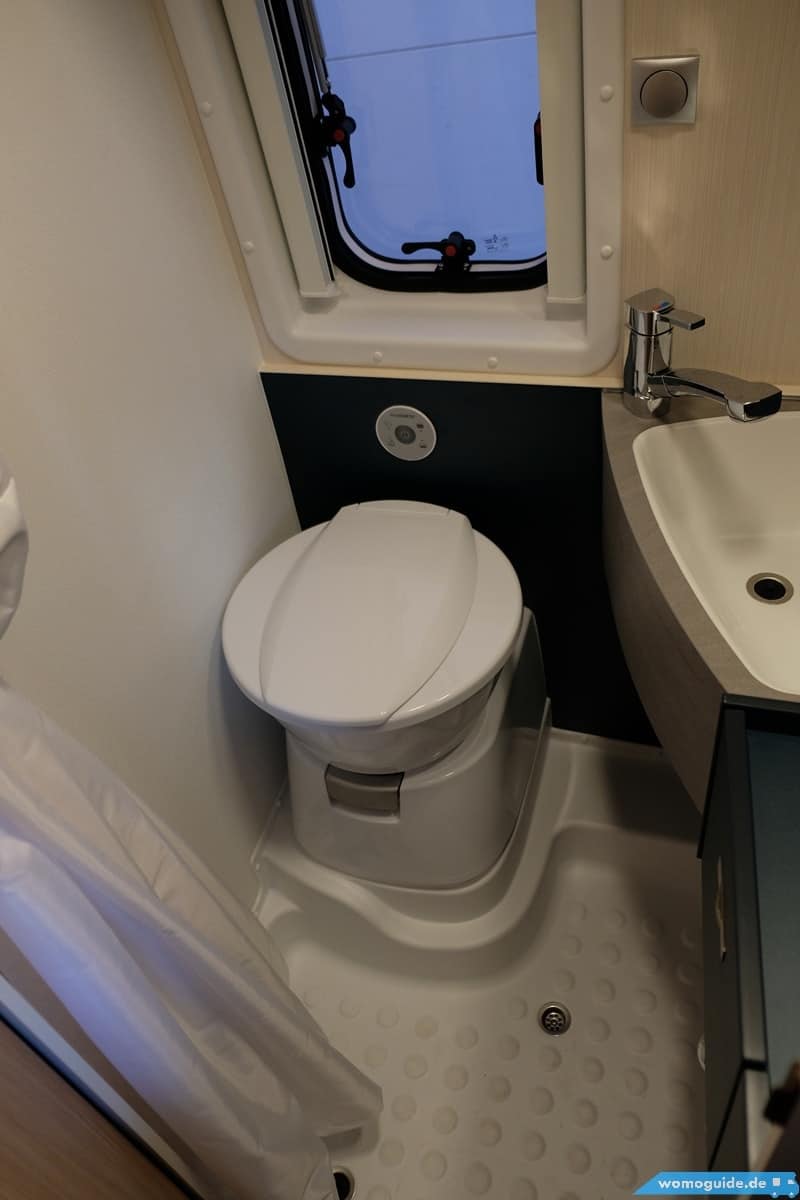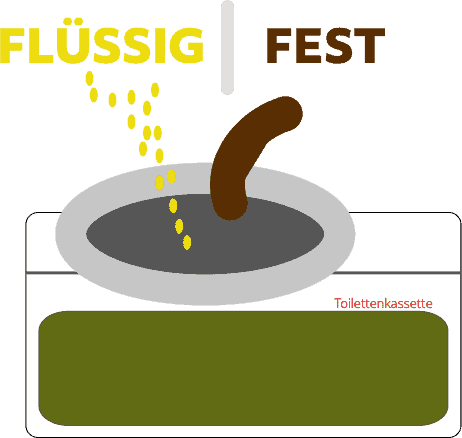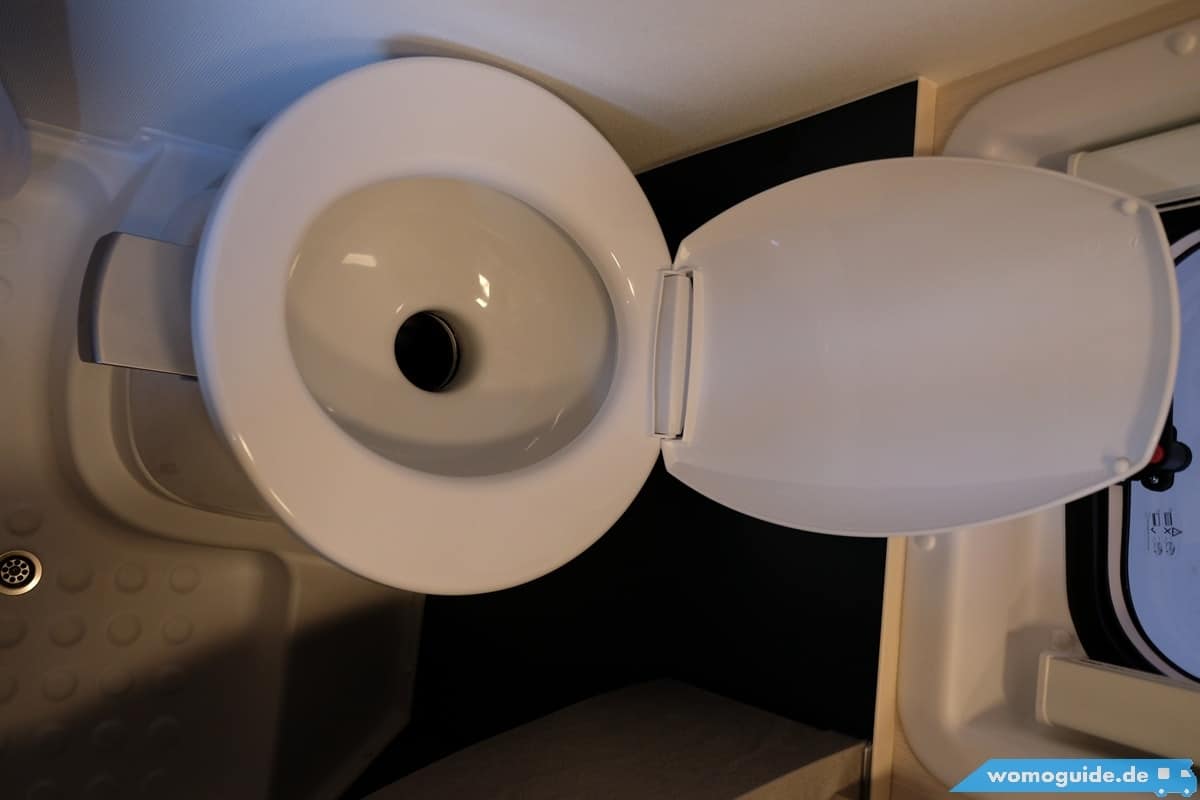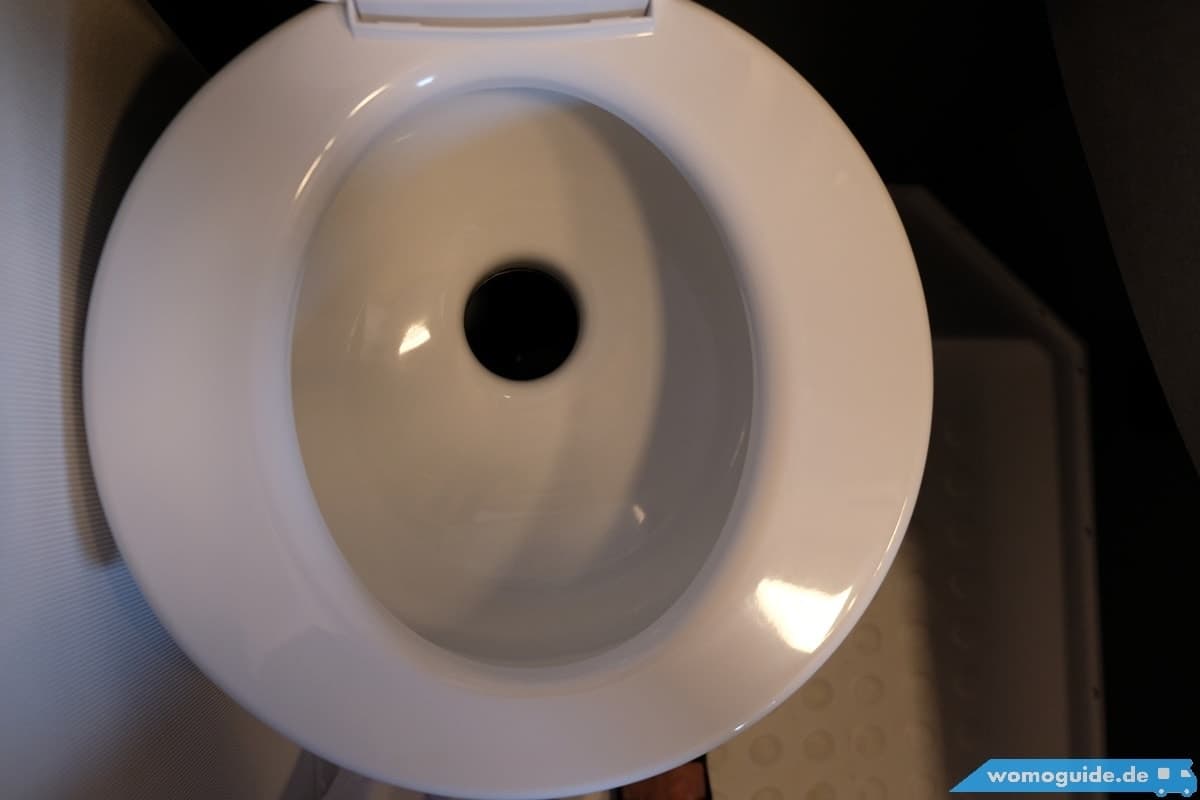Anyone who buys a van or a finished camper van in the entry- or upper-class-level will most likely find a chemical cassette toilet. The cassette toilet is an uncomplicated standard toilet for camper vans that has been tried and tested for decades. Unfortunately, this toilet technology is not without its disadvantages, which can, however, be reduced by using ecological toilet additives. You can find out how to best use and optimize your cassette toilets in camper vans here.
Inhalt
Camper van cassette toilet designs
In the wet room of a camper van there is a toilet bowl made of plastic or ceramic, which at first appears quite ordinary (albeit a little delicate).

The inner workings differ considerably from a house installation:
- Instead of leading through pipes into the sewer system, there is a toilet cassette directly under the toilet. It is quite simply a movable faeces tank that usually holds a little under 20 liters. Excretions are collected in this cassette. (In the case of large integrated vehicles and liners, there can also be a waste-holding tank located under the vehicle instead of the cassette).
- The toilet bowl and the cassette are separated by a slide. This slide can be opened for use.
- The toilet also flushes quite ordinarily with water. There is either a separate tank for the rinsing water, or the fresh water tank is also used for the toilet flush. In this case, a check valve prevents flushing water from flowing back into the water tank. Camper vans use a so-called gravity flush: The toilet is mounted directly above the cassette so that the flush works by force of gravity.
- If the cassette is full (or if the smell becomes too strong), the cassette contents must be disposed of in a suitable place. For this purpose, the cassette is usually taken out of the camper van from the outside through a service flap. Free-standing Porta-Pottis are an exception – here the cassette is located in the interior of the camper van and is pulled out from under the toilet bowl for emptying.
With a cassette toilet, all the waste lands in the toilet cassette together. Since exactly this mix of solid and liquid waste leads to unpleasant smells, the so-called separation toilet is gaining popularity.

Why cassette toilets are also called chemical toilets
In order to prevent unpleasant odors as far as possible and to promote the decomposition of the contents of the cassette, chemical toilet additivies are introduced into the cassette before use, as recommended by the manufacturer. However, there are now alternatives to this.
Using a cassette toilet in a camper van
Using the caseette toilet isn’t very different to that of a normal toilet. One takes care of business, and flushes with water. In order to flush the waste matter into the cassette, a slide must be opened. Flushes operate either electrically (with a button) or mechanically (with a pump).

Clean less after using the cassette toilet
Specifically, there are different strategies to avoid unnecessary cleaning work:
- “Skid marks” can be avoided by opening the slide before going to the toilet and then aiming well. Unfortunately, with this approach, the smells from the cassette can also spread unhindered in the wetroom while using the toilet. In addition, it is relatively difficult to maneuver the dry toilet paper into the cassette. The flushing water only partially catches the toilet paper through the open slide.
- Leaving the slider closed while using the toilet reduces the odor problem somewhat. However, this inevitably results in skid marks after number two, which you then have to clean with a brush. If you let some flushing water run into the toilet bowl before opening the slide, the toilet paper becomes soaked and drains better.
- If you leave the slide closed and flush water into the toilet bowl (similar to how an American toilet works) before the big business, this can prevent the formation of traces in the toilet bowl. After the business is done, you open the slide and the water takes all the waste into the cassette with it.
- An alternative strategy is to line the toilet bowl with paper before number two. When flushing, the waste slides down into the cassette on the paper.


Instead lining with toilet paper, one can use products designed for this purpose.
Protect your camping van wet room from flooding
Important: You should get into the habit of making sure after every visit to the toilet that no toilet paper is trapped in the slide. Jammed toilet paper prevents a tight seal. When you start driving, you might find the contents of the toilet in the wet cell again: Very unpleasant!
In addition, you should always take a look at the level indicator (if available) to avoid overfilling your cassette. Alternatively, with the slide open, you can also see inside the cassette. The fuller a toilet cassette is, the more difficult it is to empty later.
Toilet brushes camper vans
Unfortunately, not all traces in the toilet bowl can be completely prevented. Commercially available toilet brushes is camper vans are problematic: Due to the very small amount of water used for flushing, it is very difficult to clean.
A special toilet brush without bristles can help. Although this does not clean as effectively, it is very easy to clean and, therefore, a good compromise for camper vans.
Emptying the cassette toilet
At some point the cassette is full and needs to be emptied. Disposing of the chemical toilet contents in a camping van is not a pleasant thing, but if you do it right, it’s not half as bad.
Where you can empty a camping van toilet
A camping van toilet can, of course, only be emptied at designated disposal stations and toilets. Campsites, overnight stops and, in many countries, highway rest areas offer dump and fill stations.
Not every common toilet is automatically suitable for disposing of chemical toilet waste. Organic sewage treatment plants in particular can be damaged by chemical toilet additives. Modern campsites sometimes use such wastewater treatment plants. However, you will usually be informed about this by a sign.
In southern countries, toilets are not always connected to the sewer system, and chemical toilet additives would end up uncleared in rivers, lakes, the sea or in septic tanks (and later on fields).
If you know that you will have to fall back on normal toilets for disposal, it is important not to use any questionable additives.
Emptying the camper van toilet in ten steps
Emptying the camping van toilet is not hard. Still, it is advisable to keep a few tips in mind.
- Using rubber gloves, you not only avoid spreading germs, but also feel cleaner afterwards.
- Remove the toilet cassette from the service flap or the interior. Make sure the toilet slide is fully closed beforehand.
- Depending on the version of the toilet cassette, there may be wheels to help you transport it to the disposal station, with which you can pull the cassette like a trolley case. Alternatively, carts are also available for the same purpose.
- Unfold the drainage pipe and unscrew the cap! Warning: this is not the toilet slide on top of the cassette.
- Empty the contents into the disposal station. Since this creates negative pressure in the cassette, this only happens in gushes. To prevent negative pressure from building, you can open the vent valve at the cassette. This makes emptying go faster and without the risk of splashing.
- Now, via the disposal pipe or the slide opening, fill the cassette to about 30% with water, two or three times. After filling it each time, close the cassette, and shake it vigorously back and forth. After this empty the contents again. When only clear water comes out, you’re done.
- Close the disposal pipe again!
- Open the toilet slide and add your preferred toilet additive (if needed) (dose according to instructions). Usually a small amount of water also has to be added so that the toilet additive can be distributed in the cassette. Then you close the toilet slide again.
- Put the toilet cassette back in its compartment and make sure it clicks into place. When you go to the toilet for the first time again, it is advisable to check from above (and on any indicators) that the cassette is in place correctly.
- Carefully wash your hands with soap, plenty of water and, preferably, a brush at the end.
How long until I have to empty the cassette-toilet?
A typical cassette size is approximately 15-20 liters. In most cases, however, the unpleasant smell forces us to empty the cassette before it is full. Many toilet models offer a level indicator. At the latest, when the cassette is full, it has to be emptied.
A chemical toilet needs to be emptied more often the higher the outside temperature is (and of course, the more you use it).
In summer, it is recommended to empty it every two to three days, after that it becomes uncomfortable. Also here, the toilet chemical influences this.
In winter it can of course take longer, but here again it is important to ensure that the toilet contents cannot freeze. This can be counteracted by adding anti-freeze (normal windscreen anti-freeze for cars). However, many camping van travelers avoid using it in winter.
Camping toilet paper
Camping toilet paper is advertised as being easier to fall apart.
From experience we can say that this is completely unnecessary for cassette toilets. Ordinary toilet paper works just fine. When other websites report “possible damage”, we wonder how toilet paper is supposed to damage a plastic toilet cassette. We suspect this is more about sales.
We can only imagine a benefit for macerator toilets, or if you want to use the cassette toilet without any additives, in which case non-decomposed toilet paper could clog the cassette.
Cleaning the camping van toilet
Its good to clean the camping van toilet cassette regularly. Be careful not to use cleaning agents that can dissolve plastic. Luxury camping pitches even offer cleaning machines for cassettes.
Caring for the camping toilet
Caring for the camping toilet should include a regular seal change. This will prevent leakage problems. You can also smear the seal with petroleum jelly every few weeks to keep it supple.
Keine Produkte gefunden.
Chemicals for the camper van toilet
How toilet chemicals work
The chemical additives for the camping toilets prevent odors and help decompose the excrement. Depending on the product, this is done by suppressing or stimulating bacteria.
Why toilet chemicals are problematic
Excessive chemical additives can damage sewage treatment plants.
The bacteria used in the sewage treatment plants are impaired or killed by the additives, and the sewage treatment plant can no longer do its job. Organic sewage treatment plants, in particular, can not tolerate chemical additives.
Since you do not always know in advance where you are going to empty your toilet when you are out and about, chemical additives are not without problems. However, opinions differ as to whether the quantities used in motorhome toilets are actually relevant, compared with similar, but much more aggressive chemical toilets, for example, on festival grounds or construction sites.
The best toilet chemicals for camper vans
The best known toilet additive in German-speaking countries is Aqua-Kem Blue. This solution has been tried and tested: it not only effectively helps in avoiding odors, but also in the decomposition of the feces. It is scented and colors the toilet contents blue, which helps psychologically when emptying. The recommended dosage can be greatly reduced if the cassette is emptied frequently. We have had good experiences with it for years – even if we are now trying to do without it.
Aqua-Kem Blue is now also available in sachet format: a little more practical, but the experience reports are not quite as convincing, and you lose the ability to vary dosage as needed.
Operate the camper van toilet without chemicals
Running the camping toilet without chemicals? Not possible, says the chemist. Viewed correctly, everything you pour into the toilet is chemistry. This starts with waste products and of course continues with all additives. The expression “without chemicals”, therefore, actually means biologically harmless and perfectly degradable products. Using such alternatives instead of dumping toxic and potentially harmful substances into nature is, of course, unquestionably preferable.
Aqua-Kem Green: Even the manufacturer Thetford only describes the green variant as “environmentally friendly” (in quotation marks). You can empty the contents of the toilet with this “biologically active” sanitary additive into septic tanks, but never into nature. The solution is not that green after all, and in terms of effectiveness, the green solution cannot keep up with the blue one.
The product “Ammovit”, which comes from agriculture, seems to be in a better position. Only recently has this product been advertised for camping use.
According to the manufacturer, it is ecologically harmless. Ammovit helps prevent odors and helps decompose excrement. A small disadvantage is that it discolors plastic, so it should not be put into the cassette through the toilet bowl, but preferably directly through the cassette slide after emptying.
Ammovit can be purchased in bulk at hardware and gardening stores (5kg containers). Smaller 1kg packages are now also available for campers. The “complete package” contains a measuring spoon, cleaner and toilet paper. We think the 1kg pack is enough.
Another often-reccommended product is Awiwa WC mobil. It is also biodegradable.
- ✅ VIELSEITIG: Die Sanitärflüssigkeit ist vielseitig einsetzbar als Zusatz Campingtoilette und Fäkalientank Zusatz für Chemietoiletten und Kassettentoiletten in Wohnmobilen, Wohnwagen oder Booten.
- ✅ MIKROBIOLOGISCH: Der WC Zusatz ist die umweltfreundliche Alternative für Chemietoiletten. Durch Mikroorganismen wirkt awiwa auf natürliche Weise und der Tank kann problemlos entleert werden.
- ✅ HOCHEFFEKTIV: Der Toilettenzusatz Campingtoilette zersetzt Fäkalien und Toilettenpapier, verhindert ein Verstopfen beim Ausgießen und schützt vor unangenehmen Gerüchen. Ganz ohne aggressive Chemie!
- ✅ ERGIEBIG: Schon kleine Mengen führen zu einem großen Ergebnis. 1l Sanitärflüssigkeit reicht für bis zu 20 Anwendungen und ist somit deutlich ergiebiger, als herkömmliche chemische Reiniger.
- ✅ VERTRAUENSVOLL: Profitieren Sie von unserer jahrelangen Erfahrung im Bereich Camping Reiniger und überzeugen Sie sich selbst von unseren Produkten - Made in Germany!
Will chemical toilets soon be banned in camper vans?
No, Don’t worry.
The Promobil magazinemade an April Fool’s joke on 1.4.2014, claiming that chemical toilets would soon be banned due to an EU regulation. This is of course not true, but since then it has not prevented various websites from spreading this joke report as a fact.
Manufacturers and models of chemical toilets for camper vans
As with refrigerators, Thetford and Dometic are the manufacturers whose products you will most often find in camper vans.
Portable chemical toilets
The “Porta Potti” is known as a flexible solution for camper vans. It is a toilet and tank in one and does not require a permanent installation. This makes it an uncomplicated emergency solution for on the go.
Emptying is not fundamentally different from a permanently installed cassette toilet.
Keine Produkte gefunden.
A camping toilet without chemicals?
If you want to do something good for the environment, or travel to regions where proper disposal of a chemical toilet is not possible, there are several options.
- Switch to safe toilet additives
- Help yourself with plastic bags (see next section)
- Expand the cassette toilet with the SOG system or a fixed tank/macerator system
- Rely on a different toilet technology (such as separation toilets)
Plastic bags in the cassette toilet
Similar to a bucket toilet, you can also use a cassette toilet by putting a plastic bag in the toilet before doing business. However, due to the lack of absorbent material, this is primarily suitable for number two. You then dispose of the plastic bag (tightly closed!) in residual waste.
Opinions differ over the admissibility of this approach. Proponents remind us of baby diapers, which can also be disposed of in general waste. Because of the plastic bag, this option is not entirely environmentally friendly.
SOG ventilation system for camping van toilets
With the SOG system you can minimize odor nuisance and improve the decomposition process in the cassette toilet.
The SOG system removes odors to the outside via a pipe system. An electrically operated fan runs as long as the cassette slide is open. The fan creates a negative pressure in the toilet cassette, so the smells do not penetrate into the interior of the motorhome. When the cassette slide is closed, the fan does not run because the fermentation gases then cause overpressure in the cassette anyway, and thus transport odors outside via the pipe even without a fan.
Since the air exchange promotes the decomposition processes, you can do without chemical additives when using a SOG system.
The fans of the system are convinced of SOG, the experience reports on the SOG system are consistently positive. Disposal is hardly any more difficult: Before removing the cassette, the ventilation hose is pulled off and the opening is closed with a stopper.
The SOG system is offered as a kit for a variety of toilet models, so retrofitting is no problem. There are many instructions on the internet on how to install the SOG vent yourself, e.g. at our colleagues from Womo.blog. It is important to choose the right kit for your toilet model. Additionally, you have to give exhaust air some thought. There are three options:
- Over a chimney on the roof
- directly through the door of the cassette compartment,
- or through the vehicle floor.
The version on the roof is maintenance-free, whereas the floor or wall version uses activated carbon filters to prevent unpleasant odors next to the camper van.
Disadvantages of SOG: The fan naturally needs electricity – but only as long as it is running. There have been reports of unpleasant smells outside the camper. However, there is a carbon filter that is designed to prevent this from happening. If you do not replace this filter, there is a risk of odor nuisance.
What does a SOG system cost?
An SOG system costs around 130-180 euros in online camping stores or at Amazon (depending on the toilet cassette). If you don’t want to install the SOG yourself, experience reports suggest that you have to count on about 2 hours of installation time. This is heavily dependent on the exhaust air duct selected (via the outer wall, floor, roof). However, the costs are within reasonable limits.
- Bezeichnung:
- SOG-II Typ B
- Beschreibung:
- für C 200
- Packmaß:
Alternatives to the cassette toilet in camper vans
Find alternatives to the cassette toilet here.
Conclusions
The cassette toilet in camper vans is so widespread for a good reason. It is inexpensive to build and easy to operate. However, as a responsible camper you should deal with alternative toilet additives and, above all, exercise caution when disposing of the chemical toilet contents. Do you have any special tips on the subject of chemical toilets? Leave a comment!













Leave a Reply